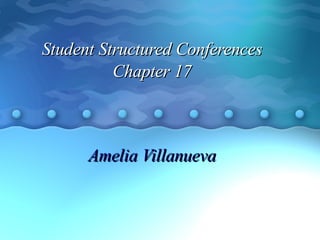Ch17 Etec
- 1. Student Structured Conferences Chapter 17 Amelia Villanueva
- 2. No other Mind tool facilitates constructive, social learning better than asynchronous discussion boards because they support reflection on what one knows and through communication comes conceptual change. David Jonassen Student Structured Conferences Discussion Boards
- 3. Synchronous tools enable real-time communication and collaboration in a "same time-different place" mode. These tools allow people to connect at a single point in time, at the same time. Synchronous Web Conferences Chat White Boarding Instant Messaging Video or Audio Conference Application Sharing
- 4. Asynchronous tools enable communication/ collaboration over a period of time through a " different time-different place " mode. These tools allow people to connect together at each person's own convenience and own schedule. Asynchronous Streaming Audio-Video Email Blogs Forum Web site links Narrated šÝšÝßĢshows Web Based Training Polls
- 5. Virtual Classroom Knowledge Base Construction Debates, Role Play, Simulation Long Distance Learning Discussion Board Use P. 195
- 6. Discussion Board Use STEP.1 STEP.2 STEP.3 Learners read messages created by other members Facilitate constructive, social learning Collaborative Communications
- 7. Learners perceive themselves as reflecting more Responding to Messages Problem Solving Analytical P. 196 Discussion Board Use Made fewer social/off-task comments during conference sessions Enhances meta cognitive skills as self-reflection and revision in learning
- 8. Lack of Engagement caused by: P. 196-197 Poor Instruction Rubrics Classroom Culture Instructors explain participation in terms of number of postings. Rubrics are poorly constructed or non-existent Students wonât take issue With othersâ Comments. Rebutting is not âfairâ
- 9. Anecdotes for Lack of Engagement P. 196-197 Rigorous Expectations Alter the Task Classroom Culture Debate Controversial Topics Specify more Rigorous expectations Conduct discussion or problem Solving tasks
- 10. Structured Discussion Boards Evaluating Student Contribution Quality Coherence Accuracy Relevance P. 203
- 11. Structured Conversation â Convince Me Advantages Socialization Reduced Fears Accessibility Lessens Conflict Collaborative Learning Enhances Writing Student Contribution P. 198-201 Convince Me Argument development Provides feedback Tools for graphing point Articulate beliefs Categorize beliefs Connect belief to support Provide believability ratings Run a coherence test of belief
- 12. Structured Conversation â Convince Me P. 198-201 http:// www.convinceme.net
- 13. Coaching with Discussion Boards P. 201-202 STEP 1 STEP 2 STEP 3 STEP 4 STEP 5 STEP 6 Coaching Discussion Boards Ensure Access Ask Engaging Questions Prompt Non Participants Provide Active Leadership Summarize the discussion Assure students
- 14. Structured Discussion Boards for Modeling Advantages Limitations Socialization Reduced Fears Accessibility Lessens Conflict Collaborative Learning Enhances Writing Student Contribution Language intensive Typing Skills Time Delays Participation Varies More Polarized Decisions Social Anxieties Absence of Verbal cues Technology Issues P. 202-205
- 15. Structured Student Conferences are changing the face of education as we have come to know it. Both asynchronous and synchronous conferencing are effective MindTools. As Jonassen notes, they â engage learners in evaluating information, discussing options, problems solving, and justifying their decisions â all of which require critical thinking.â
- 16. Thank You















